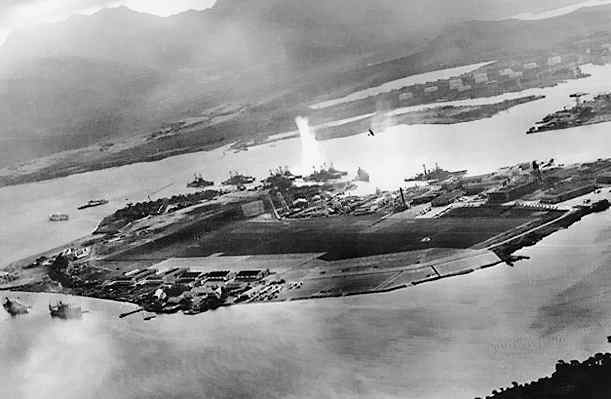Sunday, December 7, 1941

In Hawaii... The Japanese attack launched from six carriers, Akagi, Kaga, Hiryu, Soryu,Zuikaku and Shokaku, carrying a total of 423 planes, begins at 0755 local time. Its target: the main base of the US Pacific Fleet at Pearl Harbor. There is complete tactical and strategic surprise. The Japanese task force, under the command of Admiral Nagumo, also contains 2 battleships, 2 heavy cruisers as well as destroyers and support vessels including tankers. Two attacking waves strike the naval base. The first lead by Commander Fuchida is comprised of 40 torpedo bombers carrying special shallow running torpedoes, 51 dive bombers, 50 high level bombers and 43 fighters. The second wave is comprised of similar numbers with more dive bombers replacing the torpedo planes. All eight of the US battleships in port are damaged. The Arizona sinks to the bottom with most hands onboard, the Oklahoma sinks but its later raised and scrapped. The California,Nevada and West Virginia are later rebuilt and rejoin the fleet. Three cruisers and three destroyers are also sunk. The Americans lose 188 aircraft; the Japanese 29. Admiral Nagumo, despite the task forces's capacity and against advice, does not send a third wave against the base. The three American aircraft carriers serving in the Pacific are not in port and escape unharmed as does much of the infrastructure of the port, including the oil storage tanks. However, the attack leaves the Allies with only the three US carriers and two British battleships as active capital ships in the theater. The cruisers destroyers and submarines available from the Dutch and Free French reduce the numerical inferiority against the Japanese navy, however, the Allied craft are widely dispersed and under multiple commands.

In Washington... The last part of the Japanese signal, stating specifically that relations are being broken is intercepted and decoded by the Americans. Delays in decoding of the message and difficulty in securing an appointment with Secretary Hull ensure that the Japanese delegation do not meet their country's deadline for presentation of official note breaking of diplomatic ties until after the attack upon Pearl Harbor is launched.

In Tokyo... The British receive official indication from the Japanese three hours later, when their Ambassador in Tokyo is given a copy of the Japanese note. Both the British and US ambassadors in Tokyo are given declarations of war a further three hours later.
In the Pacific... Japanese forces bomb Guam and Wake and Midway is bombarded by Japanese destroyers.
On the Eastern Front... Field Marshal Brauchitsch, citing illness, offers his resignation to Hitler after the successful counterattack. It is not formally accepted but Brauchitsch is removed from important command decisions.
In Ottawa... The Canadian government declares war on Japan.
No comments:
Post a Comment